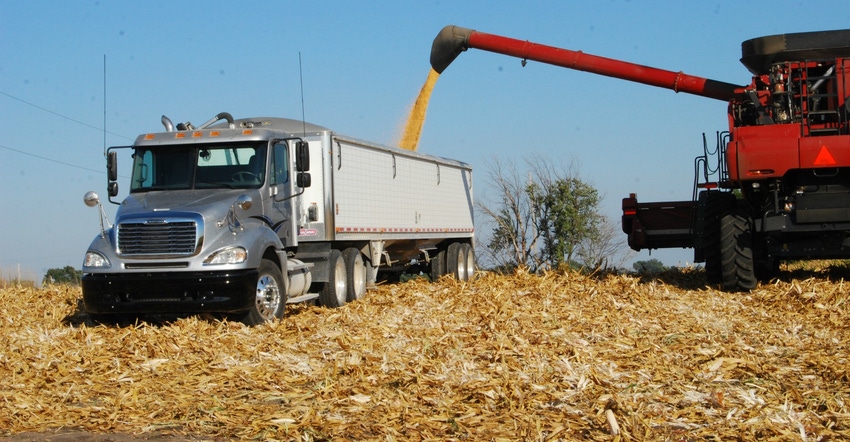
As temperatures dipped below normal across much of Iowa last week, farmers managed to find four days suitable for fieldwork. During the week ending Nov. 11, according to USDA’s latest weekly survey, many farmers wrapped up their corn and soybean harvest.
Statewide, 83% of Iowa’s 2018 corn crop had been harvested as of Nov. 11 and 94% of the soybeans. Farmers in north-central Iowa have harvested 91% of their corn, while farmers in southwest Iowa have 36% of their corn remaining to be harvested.
“The ground froze, so we could get into the field with the combine. Frozen is the new dry,” said Cliff Piasecki, a Tama County farmer. “We’re done with corn; we’ll finish soybeans today,” he said on Nov. 13.
His corn averaged 200 bushels per acre for the farm, but beans were only about 50 bushels per acre, as the wet and delayed harvest took its toll this fall. “It’s been a trying year for crop production. Glad it’s over,” he said.
On Nov. 13, Iowa Gov. Kim Reynolds signed a two-week extension to the proclamation granting a temporary weight limit exemption for trucks operating on Iowa roads. The extension will be effective through the end of the day Nov. 27, allowing shipment of corn, soybeans, hay, straw and stover by an increased weight of 12.5% per axle up to a maximum of 90,000 pounds without the need for an oversize or overweight permit.
The two-week extension for the increased weight limit will help farmers bring in the remainder of this year’s harvest.
“Farmers have now harvested 83% of the state’s corn crop corn and 94% of soybeans, which is three and four days behind average, respectively. It’s been a long and challenging harvest season for Iowa farmers to harvest crops and complete other fall field work,” notes Iowa Secretary of Agriculture Mike Naig. “The deadline to seed cereal rye cover crops has been extended to Dec. 1 statewide, so there’s still time for farmers to get cover crops planted and complete other conservation work this fall.”
The complete weekly Iowa Crop Progress and Weather Report is at iowaagriculture.gov and nass.usda.gov/ia.
Crop report
As temperatures dipped below normal across much of the state, Iowa farmers managed to find four days suitable for fieldwork during the week ending Nov.11, according to USDA’s National Ag Statistics Service. Activities for the week included harvesting corn and soybeans, baling stalks, applying anhydrous and manure, repairing tile, and performing fall tillage in areas where the ground was not too frozen.
Topsoil moisture levels rated zero very short, 1% short, 80% adequate and 19% surplus. Subsoil moisture levels rated zero percent very short, 2% short, 77% adequate and 21% surplus.
The state’s 2018 corn harvest is now 83% complete, three days behind the five-year average. Farmers in north central Iowa have harvested 91% of their corn for grain while farmers in southwest Iowa have 36% of their corn for grain remaining to be harvested. Moisture content of field corn being harvested averaged 16% last week. Soybean harvest is 94% complete, three days behind last year and four days behind the average.
Feedlots and pastures remain excessively wet and frozen in some areas. Livestock were stressed by extremely cold weekend temperatures.
Weather summary
According to Justin Glisan, IDALS climatologist, Iowa experienced an unseasonably cold week for the seven days that ended Nov. 11, as the statewide average temperature was almost 10 degrees below normal. Portions of northern and eastern Iowa observed wetter than normal conditions with southern Iowa generally drier than expected. The statewide average precipitation was 0.49 inch for the week, just below the normal of 0.51 inch.
A low-pressure system tracked northeast through Iowa on Nov. 5, bringing statewide measurable rainfall. Many stations across northern Iowa received accumulations between 0.25 and 0.50 inch; Fort Dodge in Webster County reported a 24-hour measurement of 0.74 inch.
Daytime highs were generally in the mid-40s, with cloud cover keeping overnight lows in the upper 30s and 40s. Showers lingered across northeast Iowa into Nov. 7. Rainfall totals topped out at 0.10 inch. Nov. 7 was relatively quiet with cloudy skies and highs in the mid-30s.
Measurable snow fell across parts of Iowa late Nov. 8 into Nov. 9. Accumulations averaged between 1 to 2 inches; Donnellson in Lee County had 2.4 inches.
High temperatures plunged into the upper teens in the northwest to upper 20s in southeast Iowa. Dubuque in Dubuque County observed a 28-degree high, breaking the record cold high of 32 degrees set in 1973.
Overnight lows fell into the single digits, averaging 16 to 20 degrees below normal, breaking records in some locations; Lamoni in Decatur County and Ottumwa in Wapello County observed lows of 9 degrees, breaking two 1926 records of 11 and 15 degrees, respectively.
Nov. 10 was chilly with highs in the mid to upper 20s. Overnight lows Nov. 11 again fell into the single digits. Measurable precipitation was not reported over the weekend. Fort Madison in Davis County observed the week’s high of 51 degrees on Nov. 5, which was 4.7 degrees below average. Estherville in Emmet County reported the week’s low of two degrees on Nov. 10, which was 24 degrees below normal.
About the Author(s)
You May Also Like




